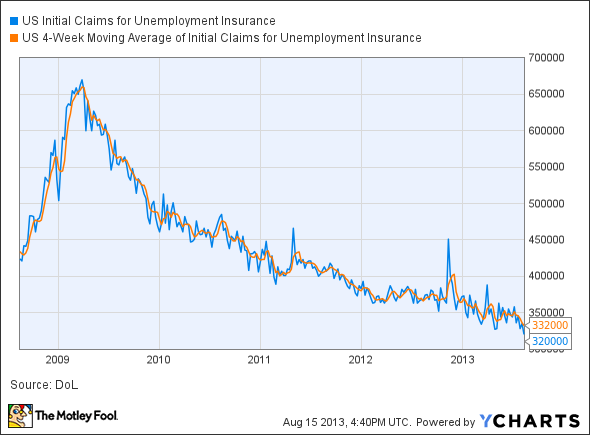Why the DJIA Is Tumbling Today
Although we don't believe in timing the market or panicking over daily movements, we do like to keep an eye on market changes -- just in case they're material to our investing thesis.
Fears of "tapering" by the Federal Reserve are pushing down the Dow Jones Industrial Average despite some positive economic reports. As of 1:25 p.m. EDT the Dow is down 223 points, or 1.46%, while the S&P 500 is down 1.41%.
There were five U.S. economic releases today.
Report | Period | Results | Previous |
|---|---|---|---|
New unemployment claims | Aug. 3 to Aug. 10 | 320,000 | 335,000 |
Consumer Price Index | July | 0.2% | 0.5% |
Core CPI | July | 0.2% | 0.2% |
Industrial Production | July | 0% | 0.2% |
Capacity Utilization | July | 77.6% | 77.8% |
Housing Market Index | August | 59 | 56 |
All were generally positive for the economy. New unemployment claims continue to fall, with the four-week moving average falling by 4,000 to 332,000.
US Initial Claims for Unemployment Insurance data by YCharts.
Inflation as measured by the CPI remained low, with 12-month inflation at 2% and 12-month Core CPI inflation -- i.e., CPI excluding energy and food -- at 1.7%.
US Core Inflation Rate data by YCharts.
The industrial-production and capacity-utilization report was the one that fell short of analyst expectations. Industrial production was unchanged from June to July, while June's growth was revised downward to 0.2%. Capacity utilization dropped in July, while analysts had called for an increase to 77.9%.
Lastly, the National Association of Home Builders' Housing Market Index rose three points to an eight-year high, reflecting homebuilders' growing confidence in the housing market.
NAHB/Wells Fargo US Housing Market Index data by YCharts.
Despite all the good news, the market has plunged today as investors grow convinced that the Federal Reserve will soon begin to wind down its accommodative monetary policies. Currently, the Federal Reserve is buying $85 billion worth of long-term assets each month in an effort to hold down interest rates and spur the economy. The Fed has said it will continue the asset purchases until inflation hits 2% to 2.5%, unemployment falls to 6.5%, or long-term inflation expectations skyrocket. Bernanke spooked the markets earlier this summer when he said that if the economy continues to improve, the Fed could pare back its easing program as soon as the end of 2013.
We are now in the peculiar situation where good economic news scares the market into thinking the Fed will end its program all the sooner. This is evident today in the large drop in long-term bonds: The yield on the 10-year Treasury rose to 2.78%. The chart below is only updated daily, but you get the picture.
10 Year Treasury Rate data by YCharts.
So what's an investor to do in this Fed-dominated market? Long-term investors would do well to ignore the market's ups and downs, focus on their investing plans, and keep their wits about them. If the drop continues, opportunities will arise for long-term investors to pick up undervalued companies.
Banks will be beneficiaries of higher interest rates, and many are undervalued. Find out about one such opportunity in "The Stock Buffett Wishes He Could Buy." The free report details the banking sector in which Buffett is heavily invested right now and details one bank that is too small for him to buy but that he likely would buy if he had less capital to put to work today. Click here to keep reading.
The article Why the DJIA Is Tumbling Today originally appeared on Fool.com.
Dan Dzombak can be found on Twitter @DanDzombak or on his Facebook page, DanDzombak. He has no position in any stocks mentioned. The Motley Fool has no position in any of the stocks mentioned. Try any of our Foolish newsletter services free for 30 days. We Fools may not all hold the same opinions, but we all believe that considering a diverse range of insights makes us better investors. The Motley Fool has a disclosure policy.
Copyright © 1995 - 2013 The Motley Fool, LLC. All rights reserved. The Motley Fool has a disclosure policy.





